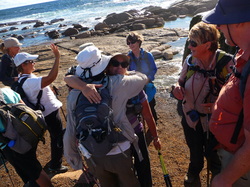Get ready for your first long bushwalk!

Get ready for your first long bushwalk!
Posted on
So you love being outside in nature, enjoy the company of others and want to stay fit and active? You have set your mind to doing a long bushwalk. Well done! Welcome to the hiking community – you will find it strangely addictive and full of the nicest people.
Here are our tips for how to prepare for your first long distance day bushwalk.
1. You walk on your feet so your boots or shoes are really important. We always get asked what sort of footwear is best. Boots, shoes, low cut, mid cut, can I do the walk in ugg boots or my old footy shoes? As long as you are not wearing ugg boots or footy shoes, generally it doesn’t matter. You might want high cut boots if you are going to be walking over lots of rocky ground (Larapinta, Stirling Ranges) or you have weak ankles, but most bushwalks offer a range of surfaces so what is good for day one, might not be so good for day two. The most important thing with foot wear is the fit. When buying new footwear, the best thing you can do is walk to the shop. Go for an hour long walk before you try on anything. This way you feet will swell up a bit and making it easier to get the right size.
Make sure you jump up and down, go down stairs, kick the ground (not the salesman) – give them a real work out and take note of ANY discomfort. Slight discomfort can manifest into debilitating hot pokers on a 20km walk. Always err on the side of too big. You can always wear more socks, but you can’t shrink your feet!
2. If you are planning a long bushwalk, make sure you work up to it. Give yourself a win to start with – try a 4-5km walk (1-2 hours) first up. There is no point starting out with a 20 km day as it will only dent your confidence and send you packing for the couch and the tube of condensed milk! A short bushwalk on an uneven surface is better than a long walk on a foot path though. Bushwalking on uneven paths with rocks, hills, etc will reveal long lost muscles that have been hiding in your slacks for decades. So be prepared to be a little sore even from a short walk…. but remember – that soreness in your muscles is your body building new muscles! Learn to love that feeling.
If you went alright on the 4-5km walk, next up, try a 10km walk and progress from there.
3. Push yourself… a bit. You probably don’t have time to do as much preparation as you want, so it is better to push the pace on a short walk to help build fitness.
Your pace will vary depending on the time of the day, what you had for breakfast, the weather and if you need to get back in time to watch Master Chef. You don’t have to go all out, but if you want to build your fitness, you have to raise the heart rate.
4. Back on the feet. Stop regularly and check your feet. If you feel any hot spot or pain in your feet STOP. Prevention is better than treatment. You should be walking with some fixomull (it is a tape which is awesome for preventing blisters), blister packs, and or hikerswool in your pack. All of these are great for blister prevention but once a blister develops your options go down quickly.
If you do get a blister, we are firmly in the “pop and drain” school. To do this you will need something sharp and sterile. This counts out sticks, tiger snakes and your walking companion. Try a safety pin dipped in betadine.
5. The number one most important thing you can do on the bushwalk itself is to stay positive. If you are walking 20 km over 6-8 hours, you are inevitably going to have a few low moments but by staying positive you will greet rain, sore muscles, man eating bears etc with zen and utter calm.
Now it is really easy to say “stay positive” but how do you actually do it? The best technique that I know of is to look for beauty. Beauty can be found every where in nature. Even in a area that has been burnt out by bush fire. The beauty is often is the smallest detail. If you can develop an appreciation and an eye for beauty, you will find people coming up to rub your belly for luck in no time at all!



